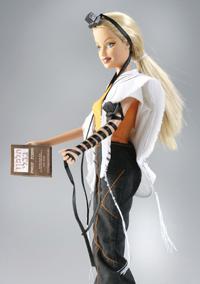 Rashi (1040-1105) is considered one of the biggest Torah commentators that God has ever given this world. His perush (commentary) is a staple of Torah study, and can be found in every book of Tanakh (the Jewish Bible) as well as the Talmud. Interestingly, he had no sons and three daughters.
Rashi (1040-1105) is considered one of the biggest Torah commentators that God has ever given this world. His perush (commentary) is a staple of Torah study, and can be found in every book of Tanakh (the Jewish Bible) as well as the Talmud. Interestingly, he had no sons and three daughters.The oldest was Jochebed. She was born in Troyes, France somewhere between 1058 and 1062. She went on to marry Meir ben Samuel of Ramerupt, which was a nearby town. According to Maggie Anton’s novels about Rashi’s daughters, Jochebed lived at Ramerupt and served as the lady of the manor, but traveled back to Troyes to be with her family often. They had four sons: Isaac (the commentator Rivam), Samuel (the commentator Rashbam), Solomon the Grammarian, and Jacob (the commentator Rabbenu Tam). The couple also had at least two daughters. One was named Hannah, and she gave birth to Isaac of Dampierre (who was the commentator Ri HaZaken and one of Rashi’s students), and another daughter whose name is unknown. Hannah also taught halachot (laws) and minhagim (customs) that were relevant to women, so she was sort of like the prototype for modern-day yoatzot halacha who do the same job. Jochebed died 1135 in Ramerupt, and her husband Meir died there a few months later.
The middle daughter was Miriam. She was also born in Troyes, sometime between 1058 and 1062. Not as much is known about her, but we know that she married Judah ben Nathan, the commentator Riban. He finished Rashi’s commentary on Mesechet Makkot, a part of the Talmud, as well as others. If you read the perush of Mesechet Makkot it literally says something to the effect of “and this is where Rashi stopped writing so now I’ll finish it.” Miriam and Judah had at least three sons named Yom Tov, Eliezer, and Shimshon, who moved to Paris to head a yeshiva. They also had at least one daughter, Alvina, who was learned like Jochebed’s daughter Hannah and set the example for the rest of the generation’s women. Miriam’s date of death is not recorded. In the Rashi’s Daughters series, Maggie Anton portrays Miriam as both a midwife and a mohelet, a female mohel. This is totally acceptable within halakha, as it’s discussed in the Talmud and R Johanan, among others, say that women have just as much right as men to perform brit milah (circumcision). There are records from the 11th century of mohelot. While it’s never specified whether or not Miriam was either midwife or mohelet, it was certainly possible.
The final daughter was Rachel. She was born sometime in the 1070s. There is barely any evidence that she actually existed, actually. One such piece of evidence is a letter from Rabbenu Tam to Yom Tov, Miriam’s son, about their aunt Rachel getting divorced from her husband, Eliezer. One of Rashi’s responsa, written when Jochebed and Miriam were already adults, talks about a young daughter losing a ring, so historians postulate that there must have been a third, much younger daughter. There are also records of Rashi having a grandson named Shemiah and a granddaughter named Miriam, neither of whom were said to belong to Jochebed or Miriam. Maggie Anton depicts Rachel as a savvy businessperson who traveled a lot, but there’s no evidence that she actually ever even left Troyes or engaged in business.
There are common legends about Rashi’s daughters. One states that they wore tefillin (phylacteries) as they prayed, a practice usually performed solely by men. In her books, Anton has Jochebed secretly put on her father’s tefillin, which is later discovered and accepted to a certain extent. All three sisters come to do so, too. Another legend is that the sisters wrote Rashi’s commentary on Nedarim. Anton stated that while it’s not totally clear that they did, there’s a good chance that it’s true.
May we all be blessed to follow in the example of Rashi and his daughters.

